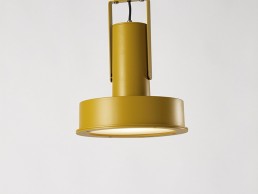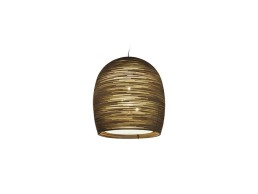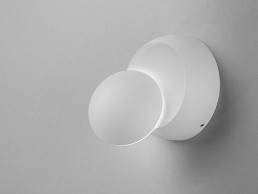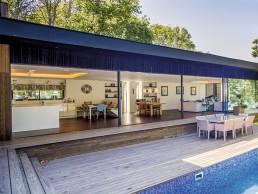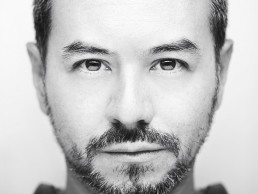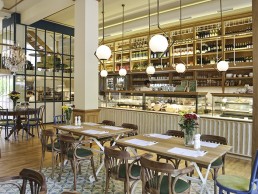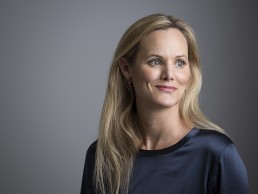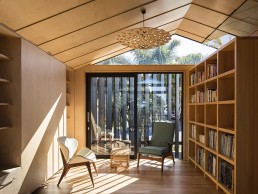lasfera SOPHIE
SOPHIE is lasfera’s sympathetic veneer lighting collection. Classic in shape and traditional in craftsmanship, SOPHIE holds a flexible veneer plywood shade and foot. The plywood is made of three layers; two natural wood and one an inner fleece layer to protect the wood from breaking. Each lamp is custom made to order.
Santa & Cole Arne Domus
Arne Domus is an urban aluminium, industrial domestic spotlight, suspended to illuminate surfaces. Characterising contemporary technology in its most natural form, the suspension lamp was designed by Arne Jacobsen with the Santa & Cole team with LED technology.
ModoLuce Florinda Desnuda
Florinda Desnuda is characterised by baroque opulence, interpreted with light freshness. Exposed to show its structure, this lamp is realised in metallic wire folded and welded by hand to create a circular composition. The plate that supports the shades is in metal, while the light sources are retro taste lamps with carbon filaments.
graypants BELL42
BELL42 original elevates the beauty, function and versatility of classic scraplights. Suited to commercial and residential settings, the BELL42 has a durable dark steel frame and a recycled cardboard shade. With multi-socket lamping assemblies and sandblasted tempered glass diffusers, BELL42 provides impact and ample light.
Shapes Luna
Luna can be used as a classic wall lamp. The top can be twisted to cast indirect light in various directions. Luna has a touch function with three levels of light to be chosen from, while the lamp’s body is available in black or white.
Fairways Residential, UK
One of the largest houses ever to feature on self-build architectural television programme Grand Designs, Fairways house on the Isle of Wight comes alive under Light Partner's illumination scheme.
Grand Designs’ Kevin McCloud was in no doubt about the significance of the nine-bedroom, 700sqm house built by Isle of Wight based architect Lincoln Miles for Bram and Lisa Vis. Aired on the British architectural design television programme in September last year, McCloud claimed the Fairways house as “one of the largest homes we’ve ever filmed… a powerful building.”
Tasked with illuminating the property was Frank Kelly of Newport-based practice Light Partners, who knew that the modern home required nothing less than an extraordinary lighting scheme to do it justice. With more than 230 Astro luminaires including trimless downlights, marker lights, pendants, shades, wall lights inside and out, this one-off beach house has them all.
Astro’s scope of supply ranged from small quantities of models such as the Ithaca pendant for over-table use, to dozens of Blanco recessed downlights, including round, square and angled varieties to suit the different spaces where they were fitted. In a few areas, the opposite approach was taken to the recessed downlight, using Astro's Osca, which sits 140cm deep in the ceiling, creating a feature in its own right. Of nearly 140 downlights fitted throughout the property, there were just 22 standard, surface-mounted downlights, which were Astro’s Vetro luminaires in black.
Downlights were the main approach for the ceilings, with the exception of pendants for the kitchen and dining spaces and the dramatic, large Bevel semi-flush shades, which set an alternative tone in the huge games room. A number of Astro’s trimless luminaires were installed in the walls before plastering, allowing the light to sit seamlessly in the wall. This includes Borgo marker lights, which were used to create an atmospheric wash of light across the timber floors.
Various approaches were used in the numerous bathrooms, three of which feature Astro’s Cabaret bathroom wall lights, reminiscent of theatre dressing room mirror lights. Others used Palermo, a tubular light fitted beside the mirror finish in polished chrome, and another featuring squared-off Romano mirror lights.
Plaster, a material favourite in Astro designs, featured strongly and was the main approach for wall lights in the living spaces and corridors. “Plaster is one of our favourite materials to design with thanks to the clean, sharp lines it makes possible,” commented Astro Design Director James Bassant. “It allows the lighting to make a complementary architectural statement which is particularly appropriate for the Vis’ stunning home.”
Plaster luminaires included 18 Pella wall lights, which project light above and below the fitting, acting as an architectural feature whether switched on or off.
For the exterior, Astro supplied six Arta Squares, finished in painted silver and twelve of the more subtle Elis wall lights. “For its variety and architectural vision, this stands out as a very special lighting project,” said Bassant. “We know that Frank Kelly and the Vis family went to considerable lengths to ensure the lighting was appropriate for the unique spaces created at Fairways. The end result is stunning and we are proud to have played a part.”
Toan Nguyen
Toan Nguyen designs product collections with fine-tuned elegance. Parisian born but immersed in Italian design culture, in this exclusive interview Nguyen explains the philosophy behind his design and why traditional approaches should never be overlooked.
Raised in Paris and now residing in Milan, Toan Nguyen knew from an early age there were only two career paths he was willing to choose between… the life of a filmmaker or the life of a designer. And so, having graduated from the exclusive ENSCI-Les Ateliers in 1995 – the only French school completely dedicated to industrial design - it was product design that took the lead and his career began. Initially working with Italian designer Antonio Citterio as head of design, Nguyen co-signed more than forty products over ten years for Axor-Hansgrohe, B&B Italia, Flos, iittala, Kartell, Technogym and Vitra to name just a few, before founding his own studio in 2008.
“My father always wanted me to follow in his footsteps and become an engineer,” Nguyen tells darc. “My brother became an architect but it was always product design that interested me, I achieved good grades from Les Ateliers and wanted to get going with my career as soon as I could. There is a strong relationship between architecture and design of course, but it was the amazing freedom you get with product design that drew me towards this career.
“Design is my job, yes, but it is also my hobby and passion. For me, it has always been about working in collaboration with companies to create something that is connected to the world of the end user. This element excites me; comparing it with the world of art, where there is just one buyer who wants to own a unique piece - to produce something that will go out into the world in its thousands is really fascinating and what sets art and design apart.”
For Nguyen, his passion for design also lies in the process. Having worked in France and Spain before setting up his studio in Italy, he is of a generation that maintains the importance of sketches, craftsmanship and prototyping. He tells darc, he feels that designers of today are losing out thanks to the development of technology: “I come from what is now considered a niche generation,” he says, “the computer was still in its infancy when I graduated and there was a real mix of how things came together, how products were designed. When I see young designers starting out, it feels as though they have lost out because they haven’t experienced it as I did – everything is computer-generated now.
“We had to draw everything and so we thought long and hard about what we did - mistakes cost time as everything would have to be done again. Now, it’s too easy to just keep printing until you’ve got it right. I think this affects the formation of ideas, there is still great value in sketching and technical drawings. It’s not just a process, it’s a way of thinking.”
A reflection of this shift in processes, according to Nguyen, is the huge amount of media interest in ‘small object designers’, as though this is a new phenomenon. “Everyone seems fascinated with it,” he tells darc, “and it’s because it is so uncommon to see craftsmanship on such a small scale, people producing prototypes and so on… it’s like ‘wow’ and this is because we’re in a world dominated by computers.”
An important decision in Nguyen’s move to Italy to set up his studio in Milan was the opportunity of working with many materials and product types. He left the Parisian design world in 1996 in search of freedom; for Nguyen the thought of working with just one product type was not something he relished, finding the Parisian way of specialised design too stifling. “What is nice about this job and what is refreshing, is facing different challenges and fields every day,” he says. “Whether it’s working with ceramics, designing a new sofa, a new lighting fixture… it makes you work in different ways as they all have different requirements.
“Milan for me, is the place where I can get to grips with a lot of different designs because the philosophy of design in Italy is much more multi-task focused rather than specialising in one area as I experienced in Paris.”
For great design, Nguyen also believes it is essential to become close to the partner he is working with at the time, telling darc: “I like to get deep inside the technicalities of the project to begin with, absorbing the DNA of the company, their processes and so on. The company you’re working with might specialise in a particular area, so to surround yourself in what they do can give you a new perspective or point of inspiration, it is about getting under their skin.”
One of the difficulties faced by product designers and brands is defining a need or reason to create new objects. Consumers don’t necessarily need a new sofa design or new desk or new lamp and so it is Nguyen’s job to find a reason for the design. “It’s very subjective,” he says, “so people could argue there’s never a real reason for new design but I try to make sure my work is not connected to just marketing reasons. Yes, this is a reason for the brand but it cannot be the only reason an object is put out into the world.”
In terms of lighting, having worked with Flos for many years, one of Nguyen’s most recent accolades through his own independent design studio, was his work with Vibia on Algorithm shown in its first form at Euroluce in April 2015. With the final product due to be exhibited at Light + Building in March this year, Nguyen explains why, for him, working with light is so different to any other form. “It’s a really fascinating world, where a lot of people do a lot of simple things and adopt a basic approach to design. A lamp can often be seen as a support component to an existing product on the market. My work with both Flos and Vibia has taken a different approach as I really considered the impact the products would have, not only in terms of the lighting quality but also the efficiency, all while thinking about the general vision of the companies involved. Lighting has to be more than functional as you can get light in many different ways.”
Algorithm, just as with nature, is the physical expression of compositional grace governed by the mathematical order that lies beneath it. Like a constellation of globes, a flock of birds or a frozen shower, this collection fuses beauty and geometry into a system of illumination.
“The intention was not to design a completely defined and finished product, but a tool which allows any customer to create their own lighting system, in relation to the architectural space, the area to light, and the desired graphic pattern,” says Nguyen.
Algorithm consists of endless compositions of light globes suspended at different heights from a ceiling anchor of tubular metal mesh, which generates its own shadows and visual effects. Manufactured from blown glass, the light globe features a striated pattern that itself creates a translucent and constantly changing lighting effect; the globes are provided with 3.15W LED dimmable light fittings.
Nguyen notes that while efficiency and the implementation of LED is extremely important, as an industry we must not forget about the physical form of the light and the materials being used; it is about “the poetry of the object.”
“Sustainability in design is something that depends a lot on the client,” he says, “but regardless, you should make sure the product will last a long time - quality comes first. As well as this, every time we find a new way of being sustainable, it becomes a reason to do another project. It is important to reduce waste, transportation, consumption, material waste and so on, which is why LED has fast become the standard. Yes, incandescent is nice but it’s not sustainable.
“Lighting is so important, it’s everywhere,” Nguyen concludes. “People like Ingo Maurer dedicate their lives to finding ways of expressing something through light. Lighting defines the quality of an ambience and its possibilities are almost endless.”
Sexy Fish, UK
It's all in the name. Martin Brudnizki Design Studio aptly filled the interior of London's new Asian seafood restaurant Sexy Fish with sea-themed floors, walls, ceilings and lights; a true underwater submersion.
If any restaurant were to draw in hungry passers-by, it would be none other than Sexy Fish in London, UK. Designed by Martin Brudnizki Design Studio (MBDS), Sexy Fish submerges guests in a restaurant interior like nothing London has ever seen before. Focusing on designing spaces that are comfortable yet beautiful, MBDS creates a sense of story-telling and intrigue in its designs.
The hotly anticipated Asian fish and seafood restaurant from Caprice Holdings restaurant group opened in October. “We have had a long established business relationship with Caprice Holdings and Richard Caring (owner),” commented Brudnizki. “I’m constantly in conversation with Richard, so when he told me about the new project, we were the natural partner.”
Working with what used to be a NatWest bank, the design brief for Sexy Fish was fairly broad – to create something very different from the building’s original identity. Brudnizki commented on the restaurant interior’s encapsulation of the quirky name: “The core of Sexy Fish’s interior is influenced by the style and sophistication of a mid-century brasserie. We created a space that was contemporary and relevant to the restaurant’s name by incorporating patterns and motifs of the ocean.”
Sexy Fish is brought to life with installations from international names in the world of architecture, art and fashion. Entering the restaurant from Berkeley Square, guests find their feet on the Esmeralda onyx floor beneath the striking coral reef mural ceiling designed by fashion journalist Michael Roberts. The ceiling, created from a cut out design carefully printed onto a fabric panel, was lit by bespoke spun dish uplighters, specially designed to project light upwards and outwards, to avoid detracting attention away from the artwork.
The statement bar provides a visual and original focal point, as the largest collection of American architect Frank Gehry’s iconic Fish lamps hang above, shimmering and glowing against the water feature behind as if undulating at sea. “Frank Gehry’s fish lamps are an integral part of Sexy Fish’s design,” said Brudnizki. “Positioned above the bar, they emanate a soft glowing quality whilst simultaneously drawing upon the aquatic theme. Shaped like fish and complete with scales, their ethereal quality creates a magical focal point to the bar area.”
Positioned at either end of the lava stone bar stop, artist Damien Hirst created a pair of cast bronze mermaids rendered in a blue patina. Further adorning the bar are seven of MBDS's own product design studio And Object's Cheriton desk lights.
MBDS sees lighting as one of the most important aspects to restaurant interior design, in the way that it creates atmosphere, sets the tone and helps diners feel at ease. “We always spend a lot of time trying to create the perfect ambience and at Sexy Fish, it was no different,” said Brudnizki. “We used uplighters in the ceiling to bring Michael Roberts’ mural to life and highlight the aquatic beauty of the design while creating a softer, more natural lighting effect. The bar is illuminated too with the use of desk lamps, with the overall effect as soft and seductive.”
Across the restaurant behind a section of raised banquettes, diners find another Frank Gehry sculpture; a glossy black crocodile in shattered formica tiles crawling across the wall. Joining this reptilian artwork in the raised area is the kitchen-dining counter with space for six, and a 3.5-metre long illuminated crustacean display.
Though Sexy Fish is busy and bold, the overall effect aims to be light and breezy, thanks largely to MBDS’ clever use of lighting. “Sexy Fish certainly creates a statement when you walk in, but once the original shock and awe of the artwork is over, you can appreciate the smaller interior details which put you at ease,” assured Brudnizki. Dining at Sexy Fish is an experience for those who like adventure and dare to delve into the depths of the sea. It is not one to be missed, and promises to tide you over from hunger to immense satisfaction.
La Maison du Grec, Greece
Recapturing the glory of Greek Neoclassicism, Greek architect Minas Kosmidis' design studio applied contemporary style to La Maison du Grec, a modern bistro in Athens.
After years of managing eateries from other owners, first time restaurateur Ntoumis Konstantinos struck out on his own to create a Greek-style bistro La Maison du Grec in Athens, Greece. Working with architect Minas Kosmidis for the interior and lighting design, having previously designed two other restaurants in Cyprus together, they approached the Greek bistro with collaborative confidence.
Kosmidis’ studio undertakes architectural and interior design projects across both private and commercial sectors, focusing mainly on food service and entertainment. Konstantinos asked Kosmidis to design a restaurant like a Greek version of a bistro, where the products used would be exclusively Greek from small local producers, with a design style similar to that of 1920’s-1950’s Athenian urban houses. This was based on the design philosophy of remodelling objects of forms of the past to help them regain their glory, so “none of the traditional elements were used without a rethinking and adaptation of contemporary living,” said Kosmidis.
Located in the affluent suburb of Kifissia, the café slots neatly into the locale’s leafy streets. “The design complements its surrounding to a tee: the airy main dining room is adorned with updated homages to classical Greek architecture," explained Kosmidis. "A mezzanine and inner courtyard at the back modelled on old Athenian houses provides shelter from the thrum of the street outside, offering a menu overseen by acclaimed Greek chef Dimitris Skarmoutsos.”
Kosmidis commented on the importance of the bistro’s lighting design to the project as a whole: “The starting point of a project is the way in which an architect manages natural light. Consequently, designing the artificial lighting of a space is an equally interesting and integral part of the process.”
One of the first points of the project to consider was the lack of natural light in the kitchen space. This was dealt with by creating a transparent wall towards the entrance, which allows natural light to enter into an opened kitchen.
Now working with an abundance of daylight, Kosmidis could consider how decorative lighting would work in conjunction. His studio custom designed all of the decorative lighting fixtures used at La Maison du Grec, except for the chandelier, to accentuate the characteristics of the bistro that make it truly Greek.
“All decorative lighting pieces designed by the studio were inspired by lighting and decorative elements of the first half of the 19th Century found in urban Athenian houses of that period,” said Kosmidis, while the old chandelier was found and bought at a flea market in Monastiraki, Athens. Be it a custom designed piece for the project or one with a history already in tow, the lighting fixtures at La Maison du Grec were carefully selected to capture the essence of Greek authenticity.
The custom made wall mounted fixtures serve to accentuate the channels of the wooden wall coating, which were influenced by the fluted ancient Greek columns found in neoclassical Athenian houses. The custom made pendants on the other hand were a combination of the forms and shapes of the custom designed tiles and the classic bistro pendant globe lamps.
La Maison du Grec’s lighting design does not just serve to cover the lighting needs of each space but creates a cosy and warm atmosphere, accentuating or darkening specific materials and textures, while most importantly reinforcing the identity that both client and designer wanted to implement.
“The final outcome of the project was actually identical to the original vision for the space," said Kosmidis. "Thanks to an open-minded client and his ability to understand complex design concepts, and his willingness to create an original restaurant, the studio was able to design and carry out the original vision to the finest detail.”
As the bistro serves to bring to life the glory and artistry of Greek neoclassicism, the lighting design itself serves to do no less. It is an intelligent selection of contemporary and classic designs that recreate an era so integral to the country’s culture, making it accessible to the modern needs of today’s Athenian bistro-goers.
Kollázs Brasserie & Bar, Hungary
The Four Seasons Hotel Gresham Palace Budapest is a historical landmark that combines the luxurious comforts of the 21st Century with the elegance of the past, considered by many to be the best hotel in Hungary. The hotel appointed dpa lighting consultants to design the lighting and work with California-based interior designers EDG Design, when it embarked upon the development and launch of its new restaurant.
The Kollázs Brasserie & Bar is a contemporary European brasserie in a vibrant location, overlooking the Chain Bridge and the Danube River. The decorative interior makes many historical references through beautiful details, sensitively selected artwork, furniture and materials. Along with the dining rooms the restaurant features an elegant patisserie, dramatic rotisserie and striking bar design, all of which are enhanced with carefully coordinated lighting.
dpa lighting consultants proposed a mixed palette of concealed, integrated lighting, decorative luminaires and discreet downlighting to sympathetically provide the elements to create a vibrant and welcoming restaurant. The hotel and EDG were extremely receptive to the ideas and together worked on developing the proposals with dpa lighting consultants, integrating details within furniture and pulling the scheme together throughout the detailed development of the interiors.
dpa lighting consultants worked closely with EDG to develop the decorative lighting with a strong local aesthetic and historical reference. The Gresham Palace is an outstanding example of Art Nouveau architecture and has retained the original decorative interior. It was this beautiful interior which set the direction for the restaurant's redevelopment; EDG produced a skillful blend of historical and contemporary design making a sumptuous interior and fantastic guest experience.
To ensure the lighting enhanced the experience in the appropriate way the design team worked with Preciosa Lighting to develop decorative chandeliers that feature multiple light sources to provide a great visual impact but soft and warm lit effect. As well as this, various decorative lighting fixtures from Patinas feature throughout the space, including a number of wall lamps from the Prague and Snooker ranges; table lamps from the Prague, Zurich and New York ranges; Genoa pendants and a floor lamp from the New York range. These were placed carefully throughout the space bringing the light sources to varying levels across the interior.
The materials palette sensitively links the lighting elements together using solid brass and handblown glass, retaining the quality of craftsmanship associated with the heritage at the Palace. Stained glass panels brought colour into the scheme and offered opportunity to highlight signage using a backlit technique. This variation of lighting throughout the space also forms part of the success of the end result and gives a good level of flexibility to alter the emphasis that the lighting can play.
A backbone of discreet architectural down lighting provides the functional framework of lighting for the decorative elements to build upon and create the drama and experience within the restaurant and bar. The decorative lighting on this project is especially important in the later dining scenes where it provides the key visual interest, spilling warm light onto the interior furnishings and picking up textures and tones of the materials used. A large feature chandelier was developed with integrated linear LED lighting as well as 20W eco low voltage tungsten halogen lamps. This offered the benefits of tiny dimensioned linear equipment and ease of integration with the warmth of the dimmed point sources. Excellent dimming was critical in achieving the scenes via the lighting control, setting moods and shifting focus within the restaurant as the evening progresses.
The restaurant is in operation all day from early breakfast to late night cocktails. In response to this flexible use the lighting changes through the day to best suit the service at any particular time with the bright and fresh daytime scenes to a more intimate dining experience in the evening. The bar becomes the main attraction after dinner when the lighting provides focus to the bespoke furniture and sparkling glassware creating a cosy and relaxed place to enjoy a late drink.
Rebecca Weir
Rebecca Weir is Creative Director and founder of Light IQ, an award-winning London-based practice which specialises in international lifestyle projects. Following Weir’s recent book release The Languages of Light: A Creative Approach to Residential Lighting here, she takes us through a journey of residential lighting design and the importance of understanding the client.
I believe deeply that in this crazy world the home should provide a sanctuary, a retreat from the madness and stimuli that threatens our existence. We live our lives at a frantic pace, switched ‘on’ to every new development whether in global politics or the changing nuances, loves and limitations of our friends and family. We should not have to find solace in a yoga studio, or on holiday but create that same wonder within our own world, the one we inhabit every day - our homes. For many years residential lighting has been seen as the underdog within the design community, not quite as sexy as lighting those large public spaces, even the awards ceremonies often fail to recognise the small achievements in creating these perfect places for families. Yet I believe that by changing the lives of one you change the lives of many. The inspiration provided to a person in their own home will often lead to commissions in their work place and to the wider community.
My views on lighting may seem extreme, but I passionately believe that lighting impacts us in ways we are yet to fully comprehend, perhaps further than our imagination will take us. For years we have known that we often feel better in summer than winter, that it is harder to get up on those dark winter mornings and at long last we have the knowledge to understand it. I believe science will shortly reveal more; why some of us are drawn to purple and others red, why young boys often prefer blue and girls pink - these views are often found under the psychology of colour but with a little more understanding and research our intuitive responses will be founded on empirical data.
It is easy for the quiet minimalist, cool in their white cave to turn their nose up at colour, just as I once did. French Post-Impressionist Paul Cezanne wrote, “Colour is the place where the mind and the universe meet’’. Never have I felt more passionately about this; daylight is dynamic in its essence full of hues of varying qualities, from the warmth of the setting sun to the crisp coolness of the northern light on an overcast day - forever changing, forever colourful, mesmerising and invigorating. Should our homes not reflect this?
Interior designers are often inspired by the palette and variance of nature. So too are lighting designers who look to the sun as their source.
It has taken years for me to see the true value of colour in a home, as I love the peace white brings, whether it is with light, paint or bed linen. However, through the eyes of my clients, who have often employed me to bring colour into their lives I have had to revisit my views and learn to ‘see’ as they do. I have noted that people often need the stimulus of colour just as others need more light in winter. It is a deep primal need. We are lucky that with today’s advances in technology a rich palette of colours is nothing more than a dmx interface away. With so many easy to use standalone systems, clients are able to play to their hearts content through a multitude of shades.
An intimate relationship often develops when lighting a family’s home, secrets are often shared to ensure needs are met. I recently worked for a famous couple whom I had incorrectly supposed shared the master bedroom. When I asked which side of the bed the lady of the house slept I was shown through to an adjoining suite. Another example is the beautiful young client who recently married a much older man, she discretely asked for a night light - I had assumed it was for the soon to be patter of tiny feet. It was in fact for her ageing husband’s frequent visits to the bathroom. It is easy for us to make assumptions. We often do about many aspects of life and particularly the people we meet. A great lighting designer I know stated very clearly at a lecture recently, “Assumptions are there to trip you up, the M…. F….’s of Design,” I could not have put it more succinctly.
Light in all its magnificence informs our world. From dawn to dusk the sensational play of the sun creates theatre by manipulating our senses, stimulating our responses and shaping our perception of space. Many of our clients see lighting as a key component to the success of their home whereas others have the architect and finances but need educating. There are many mediums in which we can encourage them to think of the importance of light in their lives. One is their use of language and their often unconscious responses; common phrases such as ‘light of my life’ or ‘light hearted’ illustrate the positive associations between light and people. It is our job as lighting designers to realise and make visible that intangible link, to create the magic, the sparkle and the brilliance.
The greatest lighting designers have a keen eye for detail and an empathy with their clients. Lighting is intimately tied to the architecture and its historical context. However, the real needs of a project are met through the careful consideration of every action and every task to be undertaken and the focus on the ergonomic relationship to the position of every switch. Once the smallest details have been considered and the requirements of the family understood then the layering of light within a room becomes infinitely easier.
When designing the lighting for someone’s home you are creating an emotional medium, a sanctuary in which to meet their psychological and physiological needs. By understanding the importance of this we are able to embrace a design philosophy that enables us to unlock the exceptional power of light.
The Languages of Light: A Creative Approach to Residential Lighting is Weir’s first book and was written to provide the student, interior designer or enthusiastic home owner with an inspirational and visual guide to the creative process of lighting. The philosophical
and human-centric approach incorporates a journey through understanding light as a basic tool, unveiling the emotional and physical responses to light, case studies and lighting effects. Lighting principles and practicalities are seamlessly illustrated through stunning photography.The fundamentals of lighting are clearly conveyed, showing how contemporary technology can assist in driving the creative process.
Boatshed residential, New Zealand
Strachan Group Architects has created a home that reflects the beliefs and needs of the family while referencing the boating and beach culture of the area.
Inserted onto a small and very difficult corner site, this elegant, light-filled assemblage of three boat-shed like structures is a superb response to the lives of a busy boating and sporting family. Robust yet elegant, full of surprises, and making inspired use of wood, glass and steel, the house is beautifully built throughout.
A superb, relaxed, confident family home with real personality, it makes a vivid streetscape contribution to its neighbourhood and as such has won numerous awards including the NZIA Architecture Award 2015 for housing.
SGA, in association with Rachael Rush, designed the house, which sits on a constrained, compact urban site, a stone’s throw away from Takapuna Beach. The three-stepped gables of the black ‘boatsheds’ appropriately reference the boating and beach culture of the area, with the sliding forms revealing a solution beyond the standard connotations of a home - a bespoke incubator for the clients’ lifestyle.
Along with their love of the ocean, the clients’ affinity for natural wood played a part in SGA’s inspiration for the house design. The clients share a passion for the warmth that wood contributes to a home as well as its ability to express exquisite craftsmanship.
The corner site, challenged by two 5m front yards and the blunt presence of a three-storey neighbour hard on the North-West boundary, stimulated an approach of layered complexity with ample transparency to capture light, sun and glimpses of the Pohutukawa and baiting ocean. Simplicity of the exterior form is contrasted by the highly crafted timber interior, exhibiting the skilled artistry of the builder. A diverse succession of multi-connected spaces creates a threaded flow of movement, whilst each maintains a distinct and sequestered quality.
The house opens and closes in response to shifts in weather and programme, with walls that lift, fall, slide, fold, shut down or disappear. This is a house with intent to engage the viewer, the viewed and the operator with sense and intrigue. The overall feel is consistent with a monochromatic approach to materiality, finishes, fittings and furniture, with the result enveloping and intricately detailed.
Feature lighting from David Trubridge was chosen for the house and at night the lights cast unique shadow effects across the voluminous patterned ceilings in lapped plywood.
Commenting on the importance of light in the project SGA Director Pat de Pont told darc: “A great deal of what this house is about is related to light, and particularly with transmission and transparency. The intention is to enlarge and animate space with light from the inside and to dissolve the building's exterior to reduce its bulk and dominance on the corner site. The building is crafted like a jewellery box with a simple, recessive exterior and a warm golden glowing interior, a lantern that only really shows itself at night.”
Some of the challenges associated with this project revolved around the building’s structure. Spread over ten split levels, with a large area of either glazing or fully exposed structure, integrating services, lighting and wiring circuits was particularly complex, according to de Pont. Wiring runs for power and lighting had to be carefully planned prior to structure being put in place and the positioning of lighting controls and fittings had to be both practically functional and aesthetically seamless.
de Pont continued: “As the owners are keen and accomplished sailors they have a unique understanding of their environment, sun, moon phases, wind direction and the vagaries of weather patterns. Partly, as a reflection of this, the house is designed with an emphasis on its relationship with the outdoors and the ability to ‘tune’ the house to the exterior conditions. This principle extends to the lighting and is particularly evident in the feature light fittings, which evoke the patterns of dappled light through the trees of our coastline or the reflecting of light off rippled water.”
Concluding, de Pont said: “The lighting provides the house with the ability to transform gracefully from a light receptacle by day into a glowing lantern at night.”

